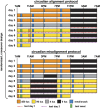Sex differences in the circadian misalignment effects on energy regulation
- PMID: 31685618
- PMCID: PMC6876189
- DOI: 10.1073/pnas.1914003116
Sex differences in the circadian misalignment effects on energy regulation
Abstract
Shift work causes circadian misalignment and is a risk factor for obesity. While some characteristics of the human circadian system and energy metabolism differ between males and females, little is known about whether sex modulates circadian misalignment effects on energy homeostasis. Here we show-using a randomized cross-over design with two 8-d laboratory protocols in 14 young healthy adults (6 females)-that circadian misalignment has sex-specific influences on energy homeostasis independent of behavioral/environmental factors. First, circadian misalignment affected 24-h average levels of the satiety hormone leptin sex-dependently (P < 0.0001), with a ∼7% decrease in females (P < 0.05) and an ∼11% increase in males (P < 0.0001). Consistently, circadian misalignment also increased the hunger hormone ghrelin by ∼8% during wake periods in females (P < 0.05) without significant effect in males. Females reported reduced fullness, consistent with their appetite hormone changes. However, males reported a rise in cravings for energy-dense and savory foods not consistent with their homeostatic hormonal changes, suggesting involvement of hedonic appetite pathways in males. Moreover, there were significant sex-dependent effects of circadian misalignment on respiratory quotient (P < 0.01), with significantly reduced values (P < 0.01) in females when misaligned, and again no significant effects in males, without sex-dependent effects on energy expenditure. Changes in sleep, thermoregulation, behavioral activity, lipids, and catecholamine levels were also assessed. These findings demonstrate that sex modulates the effects of circadian misalignment on energy metabolism, indicating possible sex-specific mechanisms and countermeasures for obesity in male and female shift workers.
Keywords: appetite; circadian disruption; energy metabolism; sex difference; shift work.
Conflict of interest statement
Competing interest statement: C.J.M. reports receiving salary from Grünenthal Ltd., UK, and that this relationship is not related to the present article. F.A.J.L.S. received speaker fees from Bayer Healthcare, Sentara Healthcare, Philips, Kellogg Company, Vanda Pharmaceuticals, and Pfizer. J.Q., R.C., W.W., and M.G. declare no competing interests.
Figures




References
-
- European Foundation for the Improvement of Living and Working Conditions , Sixth European Working Conditions Survey – Overview Report (Luxembourg, Publications Office of the European Union, 2016).
-
- McHill A. W., Wright K. P. Jr, Role of sleep and circadian disruption on energy expenditure and in metabolic predisposition to human obesity and metabolic disease. Obes. Rev. 18 (suppl. 1), 15–24 (2017). - PubMed
-
- Bonham M. P., Bonnell E. K., Huggins C. E., Energy intake of shift workers compared to fixed day workers: A systematic review and meta-analysis. Chronobiol. Int. 33, 1086–1100 (2016). - PubMed
Publication types
MeSH terms
Substances
Grants and funding
LinkOut - more resources
Full Text Sources

